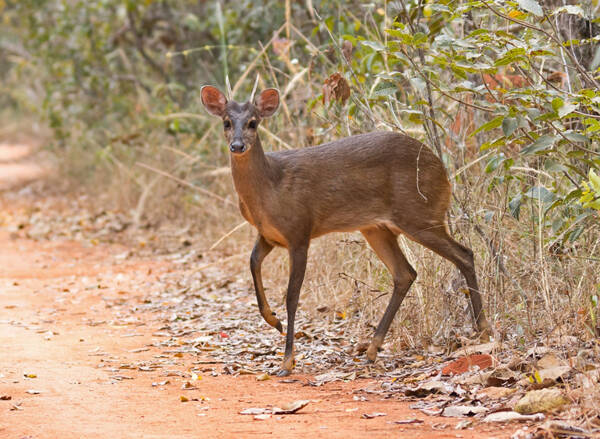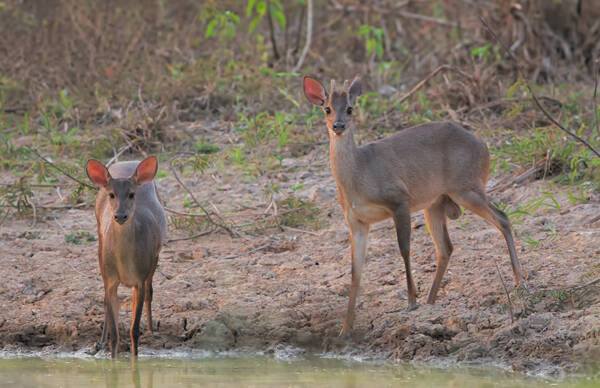Mazama gouazoubira
IUCN
LCBasic Information
Scientific classification
- name:Mazama gouazoubira
- Scientific Name:Mazama gouazoubira, Gray Brocket、Brown Brocket,Cabra Silvestre、Corzuela Común、Corzuela Parda、Guazu、Guazu Virá Corça、Veado-catingueiro
- Outline:Ungulata
- Family:Artiodactyla Cervidae Brachycerus
Vital signs
- length:88.2-106cm
- Weight:11-25kg
- lifetime:No verification information
Feature
Slightly smaller than the red shorthorn deer, with a straighter back and gray-brown to reddish-brown fur.
Distribution and Habitat
The species is found in Argentina, Bolivia, Brazil, Paraguay, and Uruguay. The gray short-horned deer is found primarily in the arid regions of eastern South America, in the pre-Andean regions of Argentina and Bolivia, extending westward to the Atlantic coast, with its northern limit south of the Amazon region and its southern limit including all of Uruguay as far as Entre Ríos Province, Argentina. Although the species has been reported throughout Brazil, evidence from 2003 suggests that it has been replaced in the Amazon by the Amazon short-horned deer (M. nemorivaga).
The gray short-horned deer occurs in moderately moist to dry areas with woody or shrubby areas. It is commonly found in open areas such as Chaco and Gran Sabana in Venezuela, among thorny scrub. These animals may live in very dry areas, or they may inhabit savannas, swamps, or the edges of secondary vegetation and transitional forests, including many types of agricultural plantations with nearby cover.
Appearance
The gray short-horned deer is a small to medium-sized deer with a head and body length of 882-1060 mm, a tail length of 83-190 mm, an ear length of 95-121 mm, a shoulder height of 500-650 mm, and a weight of 11-25 kg. The gray short-horned deer is slightly smaller than the red short-horned deer. The gray short-antlered deer's back is straighter, giving it a more deer-like profile. The species' fur ranges from gray-brown to reddish-brown. The hair on both sides of the body is lighter in color. Males have simple antlers, about 7-10 cm long. The underside of the tail is white.
In Brazil, differences in coat colour, ecology and individuals of gray short-horned deer in different regions are frequently reported. Individuals living in grasslands are predominantly light brown, while forest populations tend to be darker and grayer, with some individuals showing significant variation within populations.
Details
Gray Brocket (scientific name: Mazama gouazoubira) is called Gray Brocket and Brown Brocket in English, Cabra Silvestre, Corzuela Común, Corzuela Parda, Guazu, Guazu Virá in Spanish, and Corça and Veado-catingueiro in Portuguese. There are 11 subspecies.

In the captive study area, the home ranges of female shorthorned deer overlap, while the home ranges of males are considered exclusive. Usually solitary animals. Rarely seen in groups of more than 3. Often hide in dense brush cover during the day, but appear in the open to forage at night.
The short-horned deer communicate through scent marking, which includes urination, defecation, forehead rubbing, and patting. There are differences in the frequency of scent marking between females and between males and subadults. Females and subadults have also been observed to mark more frequently in the core of their home ranges than males who frequently mark outside their home ranges. As with almost all mammals, there may be some other forms of communication. These deer may use some vocalizations, visual signals, and body language to communicate, and physical contact signals may be important between mothers and infants, as well as between pairs.
The short-horned deer are mostly frugivorous, especially during the rainy season, from November to February. They focus on soft, fleshy fruits obtained from shrubby trees. During the dry season, they feed more on the mast crops of the dry season trees (February-October) Zyzyphus oblongifoia and Casesalpinia paraguarensis, which have dry, hard fruits. Due to the lack of water and dry season in areas such as the Chaco, the deer eat more juicy roots and leaves, as well as bromeliads and cactus fruits to meet their water needs. Graystone deer are also herbivores and herbivores, and they also eat roots, branches, flowers, buds, bark and leaves of trees and shrubs, some seasonally and some annually.

Grey short-horned deer breed almost all year round, except in May, June and July in Argentina and Bolivia. The breeding period in Brazil is associated with the rainy season. The gestation period is about 7-8 months. Usually one calf is born per litter, and twins are rare. The fawns are camouflaged in the grass, and the mother deer takes care of the fawns until they are weaned. The breeding habits are very similar to those of white-tailed deer. Simultaneous lactation and pregnancy have also been found. In some juvenile females, developing follicles were detected on the ovaries, indicating an early onset of the reproductive period. The age classes for reproduction are the same as those of white-tailed deer, with females reaching sexual maturity around one year old. Antler condition of male deer also supports the idea of year-round reproduction. Males with polished antlers have been observed year-round. Males develop velvet on their necks in January, May, and June, with polished antlers growing from May to November. Males of the species apparently shed their antlers every 18 months to 2 years, but there is considerable individual variation.
There is no evidence of population fragmentation of the gray short-horned deer, which remains abundant throughout much of its range, with populations declining or disappearing when close to human settlements. Density varies widely. In Brazil, the density is 0.35-1 per square kilometer (1997), and in Bolivia, the density is 5-12 per square kilometer (2004).
In Argentina, there has been a general decline in the number of short-horned deer due to the presence of "international hunting expeditions", hunting pressure and habitat loss (Julia 2002). In Bolivia, despite high hunting pressure, the number seems to remain constant. In Brazil, it is the most abundant deer species in the country, but populations are declining in some areas (Rio Grande do Sul, Rio de Janeiro). In Paraguay, the overall number remains constant, but the species has disappeared from recent urbanized areas and areas with high population density. In general, the overall losses are high due to killing by hunting dogs, as well as habitat loss.
Listed in the IUCN Red List of Threatened Species in 2015 ver3.1 - Least Concern (LC).
Protect wild animals and eliminate game.
Maintaining ecological balance is everyone's responsibility!








